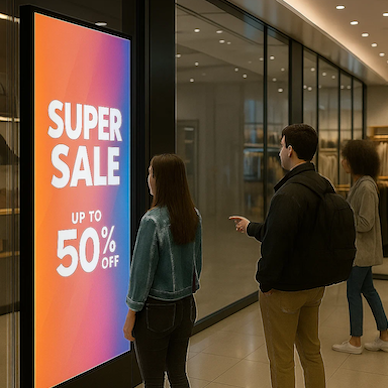The 4 Downfalls of Touch Screen Advertising You Need to Know
Touch screen displays add a level of interactivity and engagement for users, but touch screen displays have their disadvantages that businesses should know before investing their resources.
Touch screen technology has been increasingly used in advertising in recent years. It adds a level of interactivity that traditional counterparts lack, thus resulting in an increase in engagement for the user. However, touch screen displays have their disadvantages that businesses should know before investing their resources. In this blog post, we will take a closer look at the 4 major downfalls of touch screen advertising that you need to know.
Ad Blindness
One of the most significant disadvantages of touch screens in advertising is ad blindness. When touch-screen displays are placed in high-traffic areas, viewers can quickly get used to seeing them. Over time, they may become immune to the ads and ignore them completely. As a result, advertisers may invest a considerable amount of resources on interactive touch screens that end up being entirely ineffective.
Unsuitable for All
While touchscreens work great for some products and services, they might not be the best solution for all businesses. Some companies, such as bakeries and salons, rely on the human touch to sell their products. This means that a touch screen display advertising hair salon services may not be as effective mainly since customers need to meet the stylist and establish a connection first. Thus, touchscreens should not be applied indiscriminately, and businesses should weigh their options before making a costly investment in touch screen technology.
High Set up Costs
Another significant drawback of touchscreens is the high setup costs associated with purchasing the technology. While larger businesses might be able to afford the cost of purchasing a touchscreen display and the relevant technology, for most small firms, these costs could exceed their budget. Investing in touchscreen technology may not be a financially viable option for the majority of companies, especially if the results are not guaranteed.
Need for Maintenance
Touch-screen displays, like most technology, require regular maintenance to function optimally. This maintenance, including cleaning, regular software updates, and repairs, costs additional resources, which can be significant for small businesses. If the maintenance is not given sufficient attention, the display may become less effective, and the company may see less return on their investment.
While the use of touch screens in advertising can be a valuable tool, they are not without their faults. Ad blindness, unsuitability of the product, high setup costs, and the need for regular maintenance are among the drawbacks businesses should consider before investing in such technology. Companies should ensure that the potential benefits of installing touch screen displays will surpass the set up cost, maintain it optimally to optimize it for a greater ROI. Ultimately, before investing in touch screen displays, every business owner should assess whether it is the right marketing option for them and their business. To discuss an alternative digital signage option with truDigital, feel free to contact us today.
See it in Action
Get a free, no-pressure demo of our unique platform and find out how it can transform your business.









